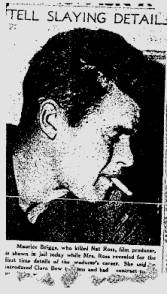

The killer with the face of a young Errol Flynn was led into the San Quentin gas chamber mid-morning on August 7, 1942. Maurice Briggs glanced around at the witnesses assembled for his state execution and, unrepentant to the end, mock-saluted them with an arm that the prison guards had neglected to strap down. Minutes later, after authorities corrected their oversight, the cyanide pellets were dropped, and Briggs’ little goodbye became his final act.
The 26-year-old drifter was not the first person to be gassed in California. That method, which replaced hanging as the official death penalty protocol, was inaugurated in late 1938. But Briggs was the only one condemned to die for killing somebody in my family.
When it came to murder sentences in our grandparents’ era, California justice felt a little like Texas today. Capital punishment was incorporated into the penal code in the rough-and-tumble 1870s, with county sheriffs assigned to carry it out in their own jurisdictions. After 1891, the job was transferred to prison wardens at San Quentin and Folsom. The ultimate punishment, officials understood required professionalism.
If you were on death row, you probably wouldn’t grow old there. While Hollywood movies played up eleventh-hour reprieves from the Governor’s office, the reality was a fairly steady use of the gas chamber, especially for homicides involving kidnapping and cop-killers.
By spring 1967, some 194 inmates had drawn their last breath at San Quentin. Change would soon blow, though. A reverberating 1972 California Supreme Court ruling that the death penalty constituted cruel and unusual punishment under the state constitution halted executions. The decision, which the U.S. Supreme Court backed the following year, took 107 people off death row. It wouldn’t be until 1992 — 15 years after California voters approved a sweeping capital punishment law opposed by former state Supreme Justice Rose Bird and other liberal jurists — that another execution would be meted out here.
When the death penalty was reinstated, the landscape was much more polarized, juiced by lawsuit-happy interest groups, victims’-rights organizations and DNA testing that freed dozens of innocent people. None of that, however, was in play for the man who took my great-uncle’s life at 36.
Briggs, much like Gary Gilmore thirty years later as the last man to face capital punishment in Utah, proclaimed to reporters he’d rather give an eye for an eye than rot away in a cinder-block prison cell.
“Just hurry things alone,” Briggs said. “I’m ready for gas or whatever they give you here in California.”
Briggs had met Nat Ross, my mother’s favorite uncle, when he’d applied for a job at the rag-making factory Ross co-owned at 17th St. and Broadway in downtown Los Angeles. Why Ross was in manufacturing at all I’ve never figured out. As a teenager, he’d been wooed by the picture business from Brooklyn to L.A., and immediately found employment clerking for Universal Pictures founder Carl Laemmle. Too skilled for gopher-work, he was promoted to directing, then producing, and wound up with a slew of feature films on his resume, not to mention pals from studio mogul Irving Thalberg to “It Girl” actress Clara Bow.
Easygoing and quirky, Ross had a soft streak that others exploited. He’d hired Briggs, a parolee from the south, as a plant laborer, fired him for unknown reasons, re-hired him out of pity and then canned him a second time two weeks later.
During his stint at Cotton Products Corp., Briggs caught the eye of an attractive 21-year-old woman who flirted with him over textile orders. They married in a whirlwind romance, but it didn’t last. She accused him of serially beating her, and threw him out.
Briggs steamed about his misfortune from his downtown flophouse. He turned up at the plant drunk with a knife one day, informing Ross his days were numbered before the police shooed him away. Though he had no proof, Briggs suspected his former boss, who was happily married, was having a fling with his girl. So, he bought a powerful deer rifle and a box of shells with his unemployment check.
During a factory late shift, while workers hustled to fill a U.S. Navy order, he knocked on a side door and asked politely to speak with Ross. As Ross walked over, Briggs grabbed the rifle he’d stashed outside and fired two close-range shots at Ross’ chest, killing him before he hit the floor. Two-dozen employees saw the whole thing, but Briggs stayed calm. He merely walked a few blocks, threw the weapon onto somebody’s lawn and told a passerby they better call the cops.
“Am I sorry I did it?” he gloated. “Yeah I’m sorry I can’t do it again!”
In the days that followed, Ross’ slaying became a media feast for the city’s three big newspapers. Workplace violence was rare, and this case had show-business angles, a dashingly defiant suspect and a beautiful woman involved.
The coroner arranged the inquest. Once Briggs was formally charged, he refused to testify, pleading not guilty despite his earlier confession. It was only when the trial got underway that Briggs ditched his tough-guy veneer and changed his plea to not guilty by reason of insanity. Testifying in his own defense, Briggs told jurors he’d bought the gun to kill himself because his ex-wife was pregnant and she intended to abort the child (an “illegal operation” back in.) Inexplicably, suicidal thoughts became homicidal ones.
The nine men and three women on the jury didn’t buy his explanation of a crime of passion: they found him guilty. After the verdict, the second part of the trial was about Briggs’ sanity at the time of the murder. The district attorney had three alienists testify his actions reflected cool premeditation. He’d bought a gun. He’d planned the ambush. The jurors agreed, and the gas chamber was where they ordered him.
The trial had lasted all of a week.
As was the custom with death penalty cases, Briggs’ was automatically sent to the California Supreme Court for appeal. The verdict wasn’t overturned. Briggs’s last hope was clemency from then-Gov. Culbert Olson. The governor granted him a month’s reprieve, why it’s not clear.
The next month it expired, and Briggs paid at San Quentin for what he took away in Los Angeles. From the time he’d shot my great-uncle to his own execution, only a year-and-a-half had passed.
A nearly identical version of this story appeared in the Pasadena Weekly as part of a special edition on capital punishment.




